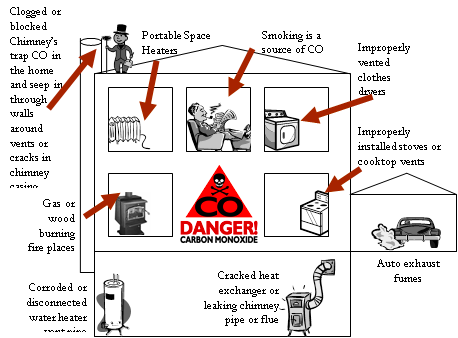Why should I worry about Carbon Monoxide(CO)?
Carbon Monoxide (CO) is a highly toxic and potentially fatal gas that is odorless, colorless and almost undetectable by humans until serious symptoms occur and even then is often mis-diagnosed. At low levels, CO can cause flu like symptoms but higher levels can lead to brain damage or death. The CO gets into the lungs and bonds with blood cells displacing the oxygen that cells need in order to function. As concentrations build up from poor ventilation, CO poisoning can become fatal. Today’s modern detectors have the ability to warn residents of the presence of dangerous levels of CO. The most common sources of CO in homes come from fossil fuel burning boilers, furnaces, water heaters, fireplaces, cigarettes and parking garages.
What are the symptoms of CO Poisoning?
The warning signs of CO poisoning are headaches, dizziness, tiredness, sudden lethargy and nausea. Often the symptoms look like flu symptoms and are mis-diagnosed. Long term exposure can lead to chronic brain damage or death when the brain is deprived oxygen. If you feel that you are suffering from the effects of CO poisoning or that your home may have a CO leak immediately open all of the windows and remove yourself from your home and call the Fire Department. Individuals with existing respiratory conditions, cardiovascular disease, or anemia are most at risk along with the pregnant women, elderly and people engaging in strenuous physical activity.
CO poisoning can be treated. The most effective and common method is oxygen therapy. Therapy replaces the CO in the blood with oxygen by either delivering oxygen through a tight-fitting mask or less commonly being placed in a hyperbaric oxygen chamber where oxygen is delivered under pressure.

How can I tell if I have a Carbon Monoxide (CO) in my building?
Carbon Monoxide is an odorless, colorless and practically undetectable by humans. For this reason, we must rely on electronic sensors to tell us how much CO is in our homes. Any building that uses any appliance or boiler that burns fossil fuels (gas, oil, wood, kerosene) will produce CO. Carbon Monoxide can also come from vehicle exhaust and tobacco smoke. The danger is in how much concentration of CO accumulates in an unventilated area. Properly adjusted appliances will ensure lower levels of CO.
How should we monitor for Carbon Monoxide(CO)?
The best way to monitor the levels of Carbon Monoxide in your home is by using a CO detector. Carbon Monoxide detection units can be combined with smoke detectors, with backup batteries. We recommend the following standard specifications.
- Have an alarm of at least 85 dB (measuring how load the device sounds) at 10 feet.
- Be equipped with a Test/Retest button, or equivalent.
- Have a manufacturer’s warranty of at least 5 years from date of purchase. ÀDetectors need to be replaced every 5 to 7 years.
- Meet UL Standard 2034 for alarm response times:
| CO Concentration | Alarm Response Time |
| 70 ppm | 60-240 minutes |
| 150 ppm | 10-50 minutes |
| 400 ppm | 4-15 minutes |
* Alarms will sound if 70 ppm of CO is continually detected for 60-240 minutes
What should I do if my alarm goes off?
Call your emergency services, fire department, or 911. Move everyone immediately to fresh air-outdoors or by an open door or window. Do a head count to check that all persons are accounted for. Do not re-enter the premises or move away from the open door or window until the emergency services responder has arrived and the premises have been aired out.
Why didn’t the fire department find CO when they arrived?
Several things may have occurred between the time your alarm went off and the time they arrived. Because your home detector and the detectors the fire department uses both are measuring for concentrations of CO, any disruption to the air mixture by opening windows and introducing fresh air may dissipate the CO concentration below detector levels. Because home detectors also measure concentration over a period of time, it may be difficult for an investigator to recreate the exact same conditions. Don’t ignore your alarm – be safe first.